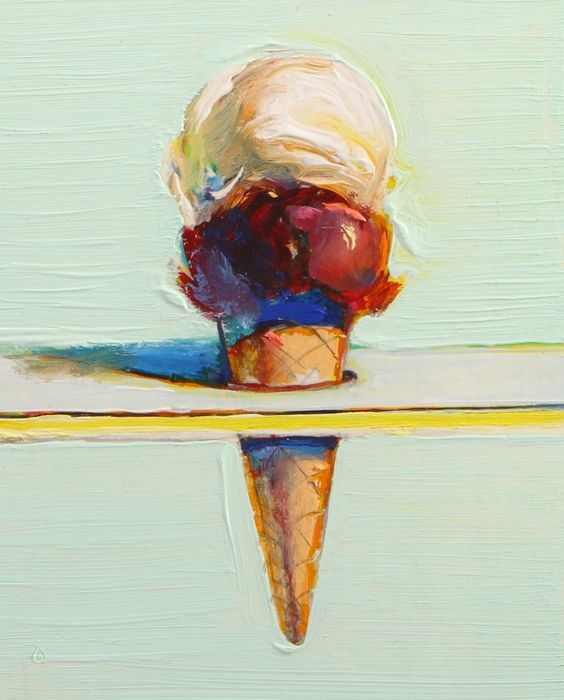Emperors of ice cream

Two Flavors (Ice Cream Cone), Wayne Thiebaud 2003
I’ve often talked with Bill Santelli about having personal, felt rules, a set of boundaries for how I paint, which create a skeleton of principles around which to make a picture I want to see–which is my first rule, actually, to paint only what I really want to look at, with almost no other consideration. It’s odd, but I can stray from this rule so easily, for one reason or another, without quite being aware how I’m gradually drifting from the delight of the true path. For a while, Bill tended to push back whenever I asserted this and then began to understand what I meant. This was no surprise since his work operates so obviously in accord with what I was saying; I think it was just that he bristled at the onerous associations he had with the word “rules.” Today, I heard the same kind of idea expressed in an interview on All Songs Considered, put into our larger nihilistic, postmodern predicament of having the license to do anything at all and call it art. It was a comment during an interview with the members of Phoenix in a discussion of the French band’s new album, Ti Amo:
The issue is that there are no more limits, in terms of music. Everything is possible. Most of our time we spend in the studio we spend it to create a frame, just to have . . . limits, so we have something coherent in the end.
All of this seems related to Kandinsky’s idea of “inner necessity,” the desire that impels you to make art in a certain, individual way–and the long search to come upon that feeling of necessity. To discover that internal compass, Phoenix will come up with a single image, like a high concept for a movie, around which to create an album. I loved hearing how the spirit of the new Phoenix album, the aesthetic of its overall sound, was centered on the gestalt, the feel, of ice cream. There was something so Thiebaud about that, to embrace that spirit, especially in Paris, of a particular kind of lush pleasure as a guiding aesthetic for a new album in this era of political vitriol and spurts of terrorist violence. It struck me as a radical affirmation of joy in art, for its own sake–like Matisse cutouts or Agnes Martin’s glowing stripes. That’s a delight to the ears of this painter who continues to paint his share of confection and candy.
We could not have released this kind of record in a period of relative happiness. We needed the darkness to come up with this naive and joyful music. We didn’t control it. It’s just what happened. We write music not really knowing what we’re doing, but when it’s done, we realize . . . we have a safe harbor for ourselves. We have hope. It’s uncontrolled.”
Those words almost sum up what I expect and desire from the unknowing act of painting, naive and joyful and willfully ignorant of whatever others think painting needs to be–how “important” it should strive to make itself–in order for the work, when it’s done, to be exactly what I want to see, even if I’m the only one who’s looking.
Comments are currently closed.